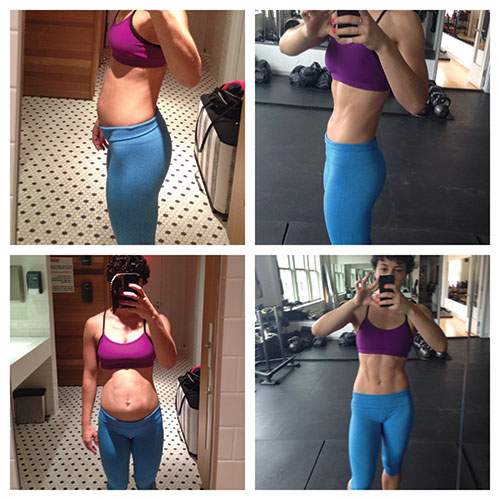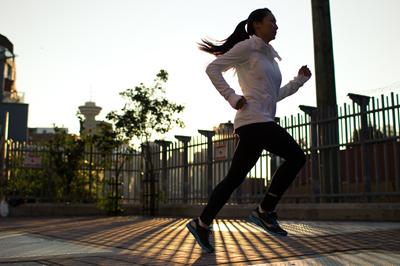Have you ever logged off social media feeling less attractive, less fit, and less satisfied than when you logged on?
If so, you’re not alone. Social feeds offer us countless daily opportunities to compare ourselves with idealized images of health and fitness. Rare is the Facebook feed without a diet or workout status update, along with an endless stream of manipulated images that look far too perfect to be anyone you know — even when they are pictures of people you know.
On Twitter, Pinterest, Facebook, and Instagram, the hashtag “#Fitspo” (short for “fitness inspiration”) appears thousands of times a week, often accompanied by photos of abs so flat they seem concave.
While pretty pictures can motivate us, spending too much time on social media in search of health inspiration can also backfire, undermining our self-confidence as we compare ourselves — consciously or unconsciously — with unrealistic ideals.
So how can you spare your body image from self-destruction? You might start by wrapping your head around just how influential and potentially damaging these idealized images can be.
Made to Measure
Fifteen years ago, seeing a picture of your former college roommate required flipping through a dusty photo album. Now, all it takes is a quick sign-in or the opening of an app, and suddenly you’re comparing yourself with her in real time as she poses in a bikini. You leave Facebook for a news site and there’s another bikini photo, this time of a movie star on the beach in Cabo San Lucas. From your perspective, they both look flawless.
Constant access to social media and online news sites means that most of us are now “deluged with celebrity images” daily, along with pictures of acquaintances in social situations, says psychologist Ray Lemberg, PhD.
What’s more, the Web “has exacerbated the degree to which we’re exposed” to modified, perfected images of bodies, says Melanie Klein, MA, professor of sociology and women’s studies at Santa Monica College in California.
And we all participate in the illusion-making. Who wants to post a picture that’s less than flattering? What mortal can resist those flaw-minimizing smartphone camera filters?
Yet this endless editing has consequences. Lemberg says he has seen “an increase in body-image concerns for both men and women” as social media has multiplied our chances for self-comparison.
This loss of body confidence cuts across age and gender. Steven Crawford, MD, codirector of the Center for Eating Disorders (CED) at Sheppard Pratt in Baltimore, notes that more middle-aged women, more males of all ages, and more older adults are being treated for eating disorders, while the number of children and adolescents seeking treatment is on the rise as well.
One in five adolescent-age boys now worries about his appearance, and half of them are actively seeking ways to increase muscle mass, according to Lemberg.
“While we cannot say that eating disorders are increasing as a direct result of social media, we do see the harmful effects of popular social-media trends among patients,” says Crawford. “Trends and hashtags like #thighgap or #bikinibridge absolutely fuel the negative-body-image fire and can trigger dangerous weight-loss behaviors.”
Research backs him up. A CED study surveyed 600 Facebook users, aged 16 to 40, and found that 51 percent felt more conscious about their body and weight after seeing photos of themselves on Facebook. Over a third wanted to change specific body parts.
Similarly, a 2014 study out of Florida State University found a direct relationship between time spent on Facebook and abnormal eating behaviors among female college students.
And a 2012 study published in Computers in Human Behavior found that for those users who rated high in “public self-consciousness,” having a greater number of Facebook friends correlated with lower self-esteem.
The sum of this research suggests that for some of us, at least, the more time we spend browsing our social-media feeds, the worse we’re likely to feel about ourselves.
The Fitspo Phenomenon
“Fitspo” is the nickname for the category of ostensibly aspirational photos that often permeate social-media sites. Sometimes the hashtag is attached to pictures of ordinary people documenting their fitness progress, but more often it features images of women with glistening biceps and rock-hard glutes and men with overdeveloped pecs and six-pack abs.
Fitspo’s sickly older cousin is “Thinspo,” an online collection of pictures of emaciated women traded mainly by users with eating disorders.
While social-media platforms like Instagram, Tumblr, and Pinterest have attempted to ban Thinspo, Fitspo pervades the Internet. Advocates say it encourages fitness and combats the cult of thinness. But captions such as “Enjoy your pain; you’ve earned it” sound suspiciously like the celebrations of self-denial that characterize Thinspo. Celebrating suffering and self-denial is not usually a precursor to confidence and self-worth.
Fitspo posts are also often imbued with a not-so-subtle tone of shame. Statements like “Failure is not an option” or “What’s your excuse?” can leave the viewer feeling that the only explanation for his or her lack of extreme fitness is a failure of effort.
Case in point: When a supremely fit mother of three posted a photo of herself with the caption, “What’s your excuse?” in 2013, the image went viral and sparked a heated emotional online debate.
Ironically, you are much less likely to see those glistening bodies in a real gym. Certified personal trainer Jessi Kneeland, founder of the body-positive site ReModel Fitness, explains that professional Fitspo images usually involve entire teams of makeup artists and lighting experts. Models often use salt-manipulating diets and other tricks to achieve their vein-popping definition. And that’s all before the Photoshop work.
This falsification can discourage the pursuit of real fitness. Crawford explains that if people find that no matter how hard they work, their bodies won’t look like the pictures they see, then they’re more likely to give up on exercise and health behaviors altogether.
Or, he says, the belief that our bodies should conform to an unrealistic standard can make some individuals more vulnerable to extreme behaviors, like excessive exercise and disordered eating.
There’s an insidious question provoked by constant exposure to these photos: If everyone else can look like that, why can’t I? And we’re even more likely to ask it when viewing pictures of our peers.
Here’s the nonshaming answer: All the tools we now use to manipulate the pictures we post obscure the reality outside the image, which is that no body is perfect (no matter how great the photo) and no two bodies are exactly alike.
When we define our fitness by how we measure up against our online idols, there will always be another glowing image that puts our real-time efforts to shame.
Happily, there are some people who are using social media to support healthier goals and to celebrate the uniqueness of real bodies instead of unattainable ideals — and you can be one of them.
Positive Body Image in the Digital Age
Tired of demoralizing, mind-manipulating online fitness images and experiences? Here are some suggestions for finding and creating healthier inspiration.
Seek and Share Honest Images
Although “we are inundated with unrealistic standards of beauty,” says Klein, we now have “the power to be the media, to set a precedent, to create a paradigm shift.”
In addition to teaching sociology, Klein is cofounder of the Yoga & Body Image Coalition (www.ybicoalition.com). The group’s website promotes broader ideals of beauty in the yoga community, hosting photos of a range of dynamic yogis, many of whom don’t conform to the now-standardized image of lean, lithe practitioners. Klein’s goal with the site is to create a “safe space for all body types.”
Other sites provide equally powerful myth-busting. The 4th Trimester Bodies Project website (www.4thtrimesterbodies.com) features photos of postpartum women in their bras and underwear, embracing the changes brought by pregnancy and breastfeeding. Its slogan is “Every body is beautiful.” (Notably, many of these images were blocked or removed by Facebook, which deemed them inappropriate.)
One of the great powers of social media is that it allows us to create and define our own standards for beauty, and to refute standards that don’t serve us. We do this every time we pin definition-broadening images on Pinterest, refrain from making Facebook comments on someone’s weight or “hotness level,” or create our own body-positive pages.
Maintain Your Perspective
Posting endlessly or exclusively about weight loss or gain, what you’re wearing, or what you’re eating (or not eating) can inadvertently “contribute to a manic cultural space where we are further obsessed and consumed with our bodies,” Klein says.
As far as self-esteem is concerned, it helps to keep body goals in a larger context. If you know that you get support from tracking your fitness journey online and receiving feedback from others, do it, but make sure you also post about your other interests from time to time. This helps offset the temptation to become obsessed with your fitness progress or appearance — or other people’s approval.
And where you can, post content that bucks the whole trend of body-fixation: Instead, put greater emphasis on the internal qualities that make us beautiful — like generosity, intelligence, and compassion.
Keep It Positive
“Bodysnarking” is the practice of criticizing other people’s bodies, often with a nasty mocking tone (think words like “cankles”). Online body criticism is “cowardly and ugly,” states Beverly Hills–based personal trainer Gunnar Peterson. Those who engage in it are “hiding anonymously behind their computers or phones.” And sadly, it’s become nearly ubiquitous across the media ranks — dozens of websites seem to exist solely to stalk less-than-flattering images of celebrities and then pounce on the “flaws” of their subjects.
Media trends aside, putting others down to feel better about yourself was not invented with the Internet, but the commenting feature makes it easier than ever to indulge this insecure impulse. If you can, think of the snarkers as misguided, then ignore their comments and refuse to join the slander.
Just as powerfully, you can decide not to snark yourself. Rather than compare yourself with Fitspo, a friend, or those famous-person photos, compare your body with . . . your body.
Embrace your unique shape and workout preferences, and take pride in what you accomplish. When you set goals, make them achievable.
Klein suggests asking yourself, “What is it about my body that I’m grateful for?”
“Instead of focusing on what you perceive to be wrong with you,” she says, “focus on what is right or good or working.”
Challenge Convention
While filtered, manipulated images may be the rule, the online world is full of self-affirming exceptions. In addition to body-positive sites like the 4th Trimester Bodies Project, consider Brooke Birmingham, whose genuine “after” photo originally was rejected by a major women’s magazine for showing too much loose skin from her 172-pound weight loss. After her story went viral and was highly criticized, the magazine decided to publish the photo.
Birmingham is just one of many who use the Internet to challenge and disrupt unrealistic body standards. There are also plenty of celebrities, like Kate Winslet, Beyoncé Knowles, and Brad Pitt, who are happy to peel back the veil of photo retouching by posting photos of themselves as they really are and calling out media outlets that go too far with Photoshop.
Meanwhile, many of these same celebrities use social media to raise awareness for causes they care about. Real people make for better inspiration than anonymous sets of six-pack abs.
Cultivate Healthy Skepticism
Amid the inspirational voices on social media, there are plenty of health and fitness “authorities” broadcasting questionable messages. Kneeland warns about the online presence of “made-up health, nutrition, and fitness advice,” which leads readers to take “ill-informed, ineffective, or even dangerous steps to change themselves.”
Investigate whether someone’s claims are corroborated in scientific literature or backed by legitimate experts. Keep in mind that social media is largely unregulated and anyone can claim to be an authority. Know the difference between a site that helps popularize ideas and one that represents hard research. Be willing to do some digging yourself.
As for imagery, assume pictures don’t tell the whole story. Peterson believes that all images of picture-perfect bodies should be accompanied by “an asterisk and a little footnote” that states, “These people work out X hours a day and have for X years and have XYZ genetics.”
Limit Your Screen Time
Reports have shown that over a quarter of 18- to 34-year-olds check Facebook before getting out of bed in the morning, and 18- to 49-year-olds spend three or more hours daily on social sites.
Three hours is a long time. As far as your fitness is concerned, at least some of that time might be better spent talking with real people, working out in a real gym, or cooking a real meal.
To reclaim some of those hours, set conscious limits on your screen time, using a timer or stopwatch. You can also try apps like SelfControl, which measures your time on specific sites, or Freedom, which blocks your online access altogether.
Crawford advises that you start by taking breaks. “Experiment by logging off temporarily and see how your mood and body image respond,” he says. Notice if you feel withdrawal symptoms, which might signal that you’re addicted to the attention or approval you get online. Shift your focus to giving yourself that approval instead.
Find Your Own Strength
However you choose to use the Web and social media, keep tabs on how those interactions make you feel. Do you leave certain sites or streams feeling motivated and energized, or tired, anxious, and inadequate? If it’s the latter, make a point to limit your time on those sites — or avoid them altogether.
And even when a site makes you feel great, it’s still important that it doesn’t become your primary source of motivation or affirmation. “For long-term sustainability, it’s better to find a way to work out that you love and look forward to that doesn’t require external motivation,” Kneeland says.
There’s nothing wrong with sharing your fitness progress and accomplishments with your social networks. Just know that while other people’s acknowledgments can be nice, the best reward is feeling strong, healthy, and at home in your real-life body, right here and now.
The Myth of the “After” Photo
Personal trainer Jessi Kneeland likes to debunk dramatic “before and after” photos, a lot of which owe their drama to a certain amount of smoke-and-mirror manipulation.
She points out that in reality, our bodies fluctuate on a daily — and even hourly — basis. She demonstrates this through a series of her own photos: two taken postmeal, and two taken after working out.
Though these were taken only a few hours apart, they seem as if they belong to a different person. And this is true for all of us. “We are constantly in flux,” Kneeland states. There is no happy ending to your fitness journey, she says, because “there is no end to your fitness journey.”

Above left: These “before” photos were taken right after Kneeland ate, and in what she calls the “worst overhead lighting ever.”
Above right: Kneeland took these “after” images just a few hours later, in a situation she describes as “great lighting, on an empty stomach, and right after I worked out. I was not pushing my belly out or sucking it in for either photo, though I was flexing my abs a bit in the second ones.”
Realistic Inspiration in a Virtual World
In the sea of manipulated body images that pervade the Internet, there are many organizations and people leading digital and social-media campaigns aimed at offering a confidence-building counterpoint. We gathered a few of our favorites, using their own words to share their missions.
What are digital sources of body-image inspiration? Leave your recommendations in the comments below.
1. Weightless by Margarita Tartakovsky, MS
Website: http://blogs.psychcentral.com/weightless
“Weightless is about fostering a fulfilling body image and life, at any shape and size. It’s about well-being, not weight. Weightless is about building a healthy relationship with food and yourself. It’s about transforming your self-care, and finding self-acceptance and self-love. Weightless is about becoming a clever consumer and recognizing when women’s magazines and other mediums tout unrealistic and damaging tips and standards.”
2. Love Your Body from the National Organization for Women
Website: http://now.org/now-foundation/love-your-body
“Every day the beauty industry and media tell women and girls that being admired, envied, and desired based on their looks is a primary function of true womanhood. They provide them with a beauty template that is narrow, unrealistic, and most importantly ingrained into their brains leaving any woman who does not fit this template feeling inadequate. The Love Your Body campaign challenges the message that a woman’s value is best measured through her willingness and ability to embody current beauty standards.”
3. Raw Beauty Talks
Website: http://www.rawbeautytalks.com/
“A conversation about beauty, confidence, and self-love.” RAW Beauty Talks originated as part of a petition by Erin Treloar, an eating disorder survivor. The intent was to expose the fashion industry’s heavy reliance on Photoshop to manufacture impossibly perfect images and ask magazines to reduce their use of them. Treloar is also the founder and CEO of RAW Beauty Talks, which offers encouragement for women and girls to find confidence in their bodies, along with inspiration and helpful resources.
4. I Am That Girl
Website: Iamthatgirl.com
“A girl’s physical, emotional, and mental well-being is rooted in her self-worth. In an epidemic of negativity, I AM THAT GIRL is helping girls transform self-doubt into self-love by providing a safe space to connect and have honest conversations about things that matter. We work to help her love who SHE IS, to see all the positives in herself, and to empower her to inspire the same in others.”
5. Operation Beautiful
Website: Operationbeautiful.com
“The mission of Operation Beautiful is to post anonymous notes in public places for other people to find. The point is that we are all beautiful. You are enough … just the way you are!”
6. Body Image Movement
Website: Facebook.com/bodyimagemovement
“My role is to harness and facilitate positive body image activism by teaching women the value and power of loving their bodies … from the inside out!” writes Taryn Brumfitt, creator of the Body Image Movement. In 2012, Brumfitt — a mother of three, writer, and speaker — was considering a breast lift and tummy tuck, and then decided against it after asking herself, “If I go through with this, what am I saying to my daughter about body image? How will I teach her to love her body?”
7. Yoga and Body Image Coalition
Website: http://ybicoalition.com/
“A yoga community committed to body love by developing, promoting, and supporting yoga that is accessible, body positive, and reflects the full range of human diversity. Our mission not only advocates yoga as an essential tool in personal transformation, from the inside out, but also includes a critical social justice component by challenging industry leaders and media creators to expand their vision of what a yogi looks like.”
8. 4th Trimester Bodies
Website: http://4thtrimesterbodies.com/
“The 4th Trimester Bodies Project is an ongoing photodoc created by photographer and mother Ashlee Wells Jackson. This project is dedicated to embracing the beauty inherent in the changes brought to our bodies by motherhood, childbirth, and breastfeeding.”
This article originally appeared as “Real Bodies in a Virtual World” in the July/August 2015 issue of Experience Life.




This Post Has 0 Comments